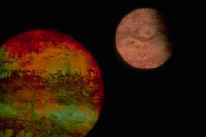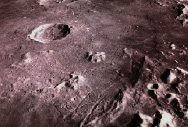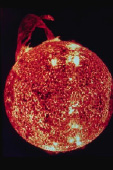

 In 1956 when I was
just beginning my journey out of
atheism, our understanding of what it takes to produce a planet that
can support life was pretty basic. We knew you needed a star with
a
certain kind of radiant energy emission, a planet with a certain size,
and with a certain chemical make-up. Since the theory in vogue at
the
time was the nebular theory (which said that all stars and planets came
from common clouds of matter floating through space), it was assumed
that there were literally thousands of planets like Earth all over the
galaxy and throughout interstellar space. I. S. Shklovskii and
Carl
Sagan wrote a book titled Intelligent
Life in the Universe (Dell Publishing, New York, 1966) which in
fact made that prediction.
In 1956 when I was
just beginning my journey out of
atheism, our understanding of what it takes to produce a planet that
can support life was pretty basic. We knew you needed a star with
a
certain kind of radiant energy emission, a planet with a certain size,
and with a certain chemical make-up. Since the theory in vogue at
the
time was the nebular theory (which said that all stars and planets came
from common clouds of matter floating through space), it was assumed
that there were literally thousands of planets like Earth all over the
galaxy and throughout interstellar space. I. S. Shklovskii and
Carl
Sagan wrote a book titled Intelligent
Life in the Universe (Dell Publishing, New York, 1966) which in
fact made that prediction.
In the last fifty years we have gained more and more understandings about what space is really like, and how many situations there are in other parts of space that would be fatal to life if those conditions existed here. The more of these variables we find, the more unlikely Earth's situation turns out to be. We have mentioned many of these things in our news and notes section of this journal over the years, but in this article we would like to be more specific and give a more comprehensive listing of what these variables are and how they impact our understanding of how special Earth is.
Collisions.
In the
late
1950s Eugene Shoemaker showed that there are certain kinds of rock that
only form under the pressures that a meteor can deliver. The
debate
over what caused Meteor Crater was finally over, and astronomers had to
recognize that astronomical catastrophes were a serious risk to life on
Earth. In the e
 arly
1990s Louis Alvarez showed that from the time of the dinosaurs there
was all over the world a clay layer containing large amounts of iridium
which could only come from an asteroid colliding with Earth. Not
too
much later a 120 mile wide depression was found at the edge of Mexico's
Yucatan Peninsula at a place called Chicxulub which contained the
minerals of the asteroid and the rocks that Shoemaker found that
indicate an asteroid collision with Earth. Now craters with
similar
conditions have been found in the Ordovician, Devonian, and Permian
periods--all of which are older than the Cretaceous. As we have
looked
up close at other planets and moons like Mars, Mercury, Callisto (one
of Jupiter's moons) and our own moon it is obvious that they have been
pulverized by repeated strikes of material from space. Our
atmosphere
burns up the smaller of these objects, but it is obvious that getting
hit by space junk is a real risk to life on Earth.
arly
1990s Louis Alvarez showed that from the time of the dinosaurs there
was all over the world a clay layer containing large amounts of iridium
which could only come from an asteroid colliding with Earth. Not
too
much later a 120 mile wide depression was found at the edge of Mexico's
Yucatan Peninsula at a place called Chicxulub which contained the
minerals of the asteroid and the rocks that Shoemaker found that
indicate an asteroid collision with Earth. Now craters with
similar
conditions have been found in the Ordovician, Devonian, and Permian
periods--all of which are older than the Cretaceous. As we have
looked
up close at other planets and moons like Mars, Mercury, Callisto (one
of Jupiter's moons) and our own moon it is obvious that they have been
pulverized by repeated strikes of material from space. Our
atmosphere
burns up the smaller of these objects, but it is obvious that getting
hit by space junk is a real risk to life on Earth.
Another potential for collisions is from comets. We now know that there is a huge reservoir of comets in a huge cloud around the solar system. If a star came close to our system, it would knock these comets loose, with perhaps hundreds of them being moved toward the Sun. This hypothetical star has been called Nemesis and astronomers have suggested that all kinds of things could happen to Earth if something like this were to take place. Not only could you have a collision with the comet, but even coming close to a comet might trigger dust and microbes that life could not withstand. So far we have not seen any stars that would qualify as Nemesis, and our computer models show that the existence of the jovian planets (Neptune, Uranus, Saturn and Jupiter) forms a wall that protects Earth from such a collision, but it remains an example of how many things can happen to Earth just from the loose material floating around interstellar space.
 Stars.
We
all know that Earth orbits a star we call the Sun. When I was in
high
school, we were told that the Sun was an average star similar to
millions of other stars in our galaxy and throughout the cosmos.
In the
past fifty years we have found that the Sun is not typical at
all. The Hubble telescope has found that an overwhelming number
of stars in
space are dwarf stars--red dwarfs, K dwarfs, and white dwarfs--all
stars that could not support a life-bearing planet. We have also
learned that most stars are not single stars like our Sun, but are
binary or trinary stars with two or more stars orbiting one
another. Planets in such a system would be too unstable to allow
life forms of
any kind to exist on them.
Stars.
We
all know that Earth orbits a star we call the Sun. When I was in
high
school, we were told that the Sun was an average star similar to
millions of other stars in our galaxy and throughout the cosmos.
In the
past fifty years we have found that the Sun is not typical at
all. The Hubble telescope has found that an overwhelming number
of stars in
space are dwarf stars--red dwarfs, K dwarfs, and white dwarfs--all
stars that could not support a life-bearing planet. We have also
learned that most stars are not single stars like our Sun, but are
binary or trinary stars with two or more stars orbiting one
another. Planets in such a system would be too unstable to allow
life forms of
any kind to exist on them.
We have also learned in the past fifty years that many stars do not die peaceful deaths. Stars having a mass seven or eight times greater than the Sun die in a huge explosion called a supernova. If we were within thirty light years of a supernova, a lethal dose of cosmic rays would be directed toward our planet. The first thing that would happen would be that our stratospheric ozone would be stripped away, allowing the ultraviolet radiation to destroy the life forms on earth and convert our atmosphere into nitrogen dioxide. In addition to this, super blasts of gamma rays would wash across the planet destroying any life form that might have survived. On February 28, 1997, such radiation was picked up from an explosion of star GRB 970228 which happened half way across the galaxy. The name given to this huge gamma blast is "hyper nova." The fact that nothing like this has happened in our neighborhood is a testimony to the fact that Earth is very unique in its isolation from such events.
 Another star issue
is the black hole issue.
Astronomers
now have a variety of different photographs of black holes, and massive
amounts of indirect evidence that shows that these huge collapsed stars
are common in space. A black hole does not have to hit Earth to
destroy
it--just coming close would produce gravitational forces that would
reduce Earth to a pile of rubble. We seem to be located in a very
rare
part of space in which the presence of black holes is not an issue.
Another star issue
is the black hole issue.
Astronomers
now have a variety of different photographs of black holes, and massive
amounts of indirect evidence that shows that these huge collapsed stars
are common in space. A black hole does not have to hit Earth to
destroy
it--just coming close would produce gravitational forces that would
reduce Earth to a pile of rubble. We seem to be located in a very
rare
part of space in which the presence of black holes is not an issue.
Galaxy Issues. We exist in a galaxy called the Milky Way. Our galaxy is one of billions of galaxies, and most of them are not like us. Eighty percent of all galaxies are elliptical galaxies, which possess virtually no interstellar material, so there is nothing to make a planet out of nor is there anything to make life out of. Some galaxies explode on a regular basis, making a stable solar system impossible. Not only is our galaxy unique, but even our location in the galaxy is special. Stars located along the equator of the galaxy cannot have stable solar systems because the gravity from the axis of the galaxy would pull any planetary system apart. Near the center of the galaxy there are massive radiation areas, probably caused by the black hole at the core of the galaxy that holds the galaxy together. No planetary system could exist in that region, because the radiation constantly would sterilize any organic compound that might exist.
 Not only are the
type of galaxy and our location in the
galaxy relevant, but the interactions of the galaxies are also
critical. We now see galaxies in space that are so close to each
other
that their gravitational fields work on each other disturbing stars and
planets that might exist within the system. Such overlapping
fields
could throw a planet right out of its solar system leaving it homeless
and in total darkness.
Not only are the
type of galaxy and our location in the
galaxy relevant, but the interactions of the galaxies are also
critical. We now see galaxies in space that are so close to each
other
that their gravitational fields work on each other disturbing stars and
planets that might exist within the system. Such overlapping
fields
could throw a planet right out of its solar system leaving it homeless
and in total darkness.
Some forty years after Shklovskii and Sagan wrote their book, numerous authors have pointed out that we are probably alone. Their point is that our knowledge since the 1950s has grown so much and we now understand so much more about how many factors have to be right to have a functional solar system that you can no longer postulate that life is common and abundant in the universe.
Skeptics will counter this argument by saying that maybe life is out there that is radically different from our kind of life. They would propose fire people, rock people, or some other fanciful form of life. This is a religious proposal in which the normal definition of life is ignored and something for which there is no evidence is suggested. We would suggest that as more and more variables become known as necessary for life to exist, it becomes less and less likely that life can be explained as a product of chance. The statement "The heavens declare the glory of God and the firmament showeth His handiwork" (Psalm 19:1) is more true today than it has ever been. Earth is not just unlikely; it is impossible by rote mechanical chance. We truly can "know there is a God through the things He has made" (Romans 1:19-22). --Reference: Natural History, May 2005, page 25.
Back to Contents
Does God Exist?, MayJun06.
02/20/2008